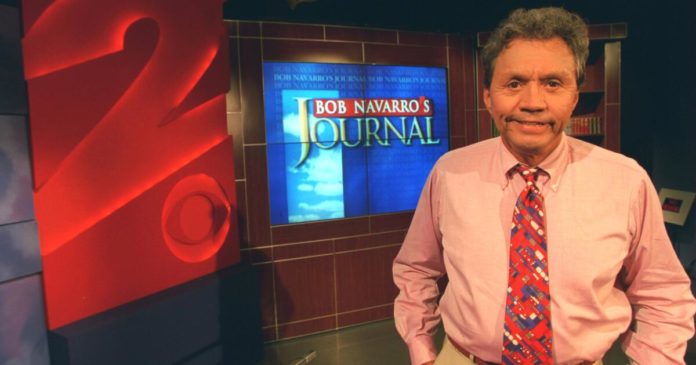At a time when few Latinos worked in broadcast news, Bob Navarro became a news writer in Los Angeles at KNXT-TV Channel 2 on “The Big News.”
The year was 1967 and, as Navarro recalled decades later, “When I first came to ‘The Big News,’ there was a woman reporter, a woman writer, no woman on the desk, no woman producer. That was it. There was an African American, but no Chicanos. I was the first one.”
Navarro later became an on-screen reporter, one of a handful of Latino reporters appearing on Southern California airwaves in the 1970s.
Navarro, who was honored with a military service at the Los Angeles National Cemetery Columbarium on Sept. 12, is being remember by former colleagues as a barrier breaker who pushed for insightful, stereotype-free coverage of the Latino community. He died in North Hollywood on Aug. 21 at the age of 92.
“Bob was always one of the friendliest and nicest guys in the news business, a business in which he experienced racism and intolerance,” said Joe Saltzman, a professor of journalism and communication at USC. “But through it all, he never lost his smile, his sense of who he was.”
Born Robert Navarro on March 15, 1932, in El Paso, he grew up in South Los Angeles but did not complete high school. He served in the Army before attending broadcasting school in Los Angeles, according to Félix Gutiérrez, a professor emeritus of journalism at USC. Navarro’s career took him to Las Vegas and later to the news writer job at KNXT-TV Channel 2, now known as CBS Los Angeles.
“His claim to fame was the quality of his work and his dedication to journalism,” said Gutiérrez.
He became familiar to thousands of Angelenos by hosting a weekly interview with his own name in the title, “Bob Navarro’s Journal.”
He touched on all sorts of topics on the show, but an episode in 1997 captured his presence — a composed, bespectacled reporter in a crisp gray suit asking piercing questions. Jumping into the hot-button issue at the time, he guided a tense conversation with people offering differing views of Proposition 227, a statewide measure that restricted bilingual education in California.
The dialogue was emblematic of the in-depth and tough discussions that appeared on his show.
Away from work, Gutiérrez noted, Navarro encouraged aspiring journalists to make opportunities for themselves and realize their potential.
Navarro was one of the founding members of the California Chicano News Media Assn., an organization created in 1972 that advocates for diversity in journalism and accurate portrayals of the Latino community. It was a particularly fraught time for Latinos, who faced racism in the struggle for equal representation.
“We weren’t integrated throughout, nor was our language, nor was our culture,” Gutiérrez recalled. Navarro’s stints at broadcast television stations — which included KPIX in San Francisco and Southern California’s KCET, KTLA, KCAL and KNBC — made strides to change that narrative.
Navarro made the switch to Spanish-language networks when Frank Cruz hired him in 1986 as news director of KVEA-TV, a current Telemundo outlet.
Cruz, a co-creator of Telemundo and Navarro’s close friend, said the journalist “led the charge” on bringing stories to Spanish-speaking audiences that accurately reflected their daily lives. In his coverage, Navarro rejected notions that Latinos were a monolithic community.
“We’ve got to do in-depth coverage stories on the Latino community and all aspects of it,” Cruz said. “We didn’t want to do stereotypical stories.”
Navarro’s near four-decade-long tenure in journalism included coverage of the Chicano Moratorium, which culminated in an August 1970 march that drew up to 30,000 demonstrators. He recalled seeing the “bloody remains” of Chicano journalist Ruben Salazar, who was killed by a tear gas projectile fired by a Los Angeles County sheriff’s deputy at the Silver Dollar Bar that day.
Navarro did not return to the Silver Dollar Bar until 20 years later, writing in The Times that he had long struggled to accept Salazar’s death.
“It took an act of denial to make me go in,” he wrote about the locale, “and it took an act of God to keep me there. Time and again my eyes would slide over to that spot on the floor where the beacon came crashing down.”
Navarro left reporting in the early 1990s to take up a position as KCBS’ director of editorials. Diversity in newsrooms had come a long way from when he began, but even then, Navarro remarked that underrepresented groups needed to have a seat at the table in leadership positions.
He encouraged his friends who taught journalism to push their students to strive for quality journalism and find the stories “no one tells about people that look like me,” according to Saltzman.
“I wish Bob could visit my USC classes today so he could see how diverse they are with faces that not only look like his but look like so many other cultures,” Saltzman said. “It would have brought one of those patented Navarro smiles to his face.”
Navarro was preceded in death by his wife, Carmel.


